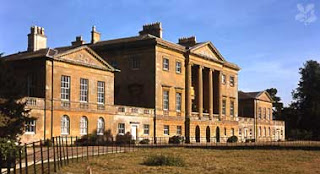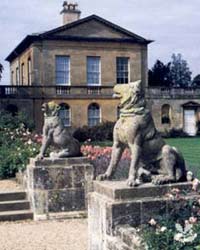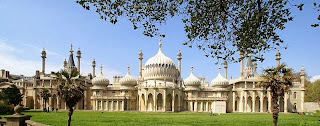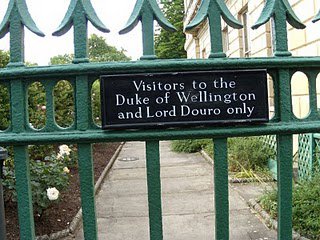Victoria here, about to get out my Roget’s to look for synonyms for fantastic and over-the-top…for I am about to write of this incredible building.
Not to mention Prince George’s secret and illegal marriage to Maria Fitzherbert, about which his father may have known. But this is not the place to discuss the many amours and several marriages of the Prince. We’ve blogged about these topics before. You might try the Forgotten Queen here or George IV’s ill-fated marriage, here.
In the late 1780’s Henry Holland, an architect who had done considerable work on the Prince’s London residence, Carlton House, began transforming the farmhouse into the attractive house above. But it was not quite grandiose enough for the Prince, and before long, he chose architect John Nash, whose ideas matched the Prince’s in exaggerated scope and pomposity, to further alter the Pavilion.
We told the story of Sezincote, the house that inspired the Prince’s fantasies, here.
The exterior of the Pavilion is almost beyond description, definitely not pure Hindoo or Chinese, or any other of its supposed stimuli, but a sort of wedding-cake confection with a style all its own: domes, minarets, etc. etc. One thing is for sure: you can’t ignore the Prince’s pleasure palace when you drive down the Old Steine toward the sea in Brighton.
BTW, I believe the Steine or Steyne is pronounced Steen.
For the official website, click here. In recent years, the gardens have been restored to their original splendor, or perhaps even more so. Is that possible? Out-Georging George? In interiors are as outré as the exterior.
In the hopes that you will be able to join us at the Brighton Pavilion on the Wellington Tour next September, I will include some other views of the chinoiserie interiors, as a temptation. Pictures will never quite do justice to the feast for the eye, however.
The Brighton Pavilion is now owned and operated by the City of Brighton. I suppose, after seeing the pictures above, it won’t be a surprise that Queen Victoria did not find the place to her liking. She sold it to Brighton in 1850, though she kept many of the furnishings for use at Buckingham Palace and Windsor Castle. Over the years, the Pavilion has been restored and developed into a popular tourist site. Some of the furnishing have been loaned back to the Pavilion by HM The Queen.
Now here is the question, what did the Duke of Wellington think of it? The Duke was a loyal servant of the crown and he followed George IV’s desires regarding the disposition of his personal effects after the King died. But one can hardly imagine that the structure appealed to the Duke’s tastes any more than it did to Victoria’s. Fortunately, we have an account of the Duke’s reaction upon first seeing the Pavilion from the letters of Princess Lieven:
January 26, 1822 – “I wish you were here to laugh You cannot imagine how astonished the Duke of Wellington is. He had not been here before, and I thoroughly enjoyed noting the kind of remark and the kind of surprise that the whole household evokes in a newcomer. I do not believe that, since the days of Heliogabalus, there have been such magnificence and such luxury. There is something effeminate in it which is disgusting. One spends the evening half-lying on cushions; the lights are dazzling; there are perfumes, music, liquers – “Devil take me, I think I must have got into bad company.” You can guess who said that, and the tone in which it was said. Here is one single detail about the establishment. To light the three rooms, used when the family is alone, costs 150 guineas an evening; when the apartment is fully opened up, it is double that.”
In any case, the Duke had to spend a great deal of time in Brighton due to Royal summons, and we hope you will enjoy touring it with us.

























_by_Thomas_Lawrence.jpg)
















_by_Thomas_Lawrence.jpg)






.jpg)





